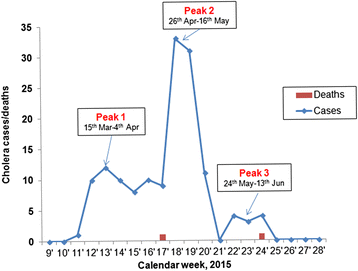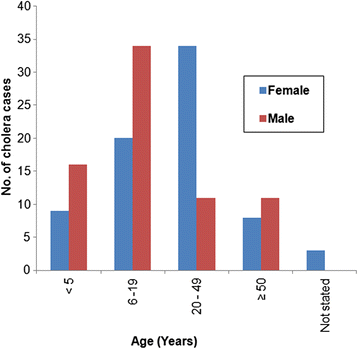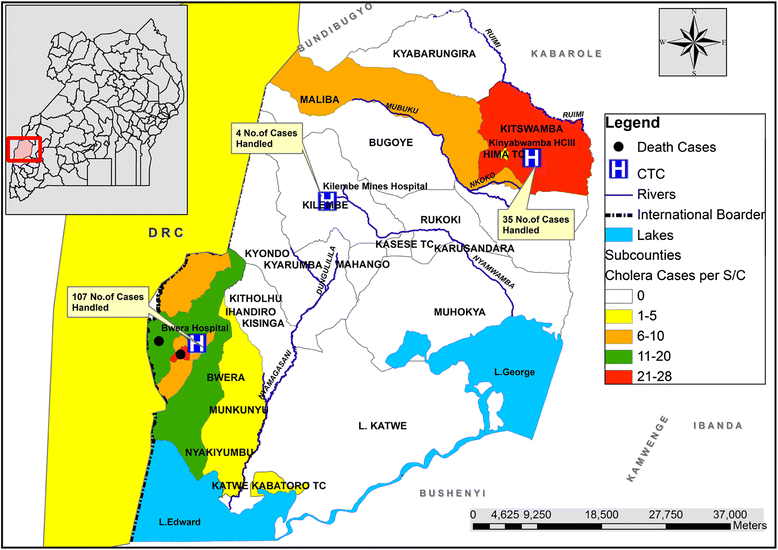Alkaline peptone water enrichment with a dipstick test to quickly detect and monitor cholera outbreaks
- PMID: 29157211
- PMCID: PMC5696767
- DOI: 10.1186/s12879-017-2824-8
Alkaline peptone water enrichment with a dipstick test to quickly detect and monitor cholera outbreaks
Abstract
Background: Detection, confirmation and monitoring of cholera outbreaks in many developing countries including Uganda is a big challenge due to lack of the required resources and the time the test takes. Culture method which takes 24-48 h to get the feedback and requires highly skilled laboratory staff plus other complex resources is the standard test. This study evaluated the new cholera rapid detection method that relies on Crystal VC dipsticks after enrichment with alkaline peptone water (APW) against the culture method for monitoring the progress of cholera outbreaks in rural setting.
Methods: We conducted the study between March and June 2015. Fresh stool samples and rectal swabs were incubated in 1% APW for 6 h at room temperature before testing with RDT following the manufacturer's instruction. The same stool sample was cultured to isolate V. cholerae in the standard manner. We also reviewed patient registers to epidemiologically describe the cholera epidemic.
Results: We tested stool from 102 consenting suspected cholera patients reporting during daytime at Bwera Hospital (n = 69), Kilembe Mines Hospital (n = 4) and Kinyabwama Health Centre (n = 29). Ninety one (91) samples were positive and nine samples were negative according to both methods. One (1) sample was positive only by dipstick and one sample was positive only by culture (sensitivity of 99%, specificity of 90%, Positive Predictive Value of 99% and Negative Predictive Value of 90%). Overall, 146 suspected cholera cases and two deaths, (case fatality rate of 1.36%) were recorded during the study period. Among the cases aged 1-9 years, 63% (50/79) were males while in those aged 20-49 years, 76% (34/45) were females.
Conclusions: Our findings showed that the modified dipstick test after enrichment with 1% APW had high level of accuracy in detection of V. cholerae and is quick, affordable alternative cholera outbreak monitoring tool in resource constrained settings. However, culture method should remain for cholera epidemic confirmation, for monitoring of antibiotic sensitivity and for production of pure isolates for molecular characterization. Further studies should be done to better understand the observed age and sex case distribution, in Kasese district.
Keywords: Alkaline peptone water; Dipstick; Epidemic monitoring; Outbreak detection; RDT; Rapid test; Vibrio cholerae.
Conflict of interest statement
Ethics approval and consent to participate
Written informed consents were obtained from the study participants (patients suspected of having cholera) and parents or guardians for the patients below the age of 18 years. Confidentiality was observed at all levels of data collection, storage, data analysis and dissemination. Permission to conduct the study was obtained from the Makerere University School of Public Health Institutional Review Board (IRB 00011353).
Consent for publication
Written informed consent was obtained from all study participants (patients suspected of having cholera) and parents or guardians for the patients below the age of 18 years. Confidentiality was observed at all levels of data collection, storage, analysis and dissemination.
Competing interests
The authors declare that they have no competing interests.
Publisher’s Note
Springer Nature remains neutral with regard to jurisdictional claims in published maps and institutional affiliations.
Figures



References
-
- Bwire G, Malimbo M, Maskery B, Kim YE, Mogasale V, Levin A. The Burden of Cholera in Uganda. Ryan ET, editor. PLoS Negl Trop Dis. 2013 [cited 2013 Dec 11];7(12):e2545. Available from: http://dx.plos.org/10.1371/journal.pntd.0002545 - DOI - PMC - PubMed
-
- Bwire G, Malimbo M, Makumbi I, Kagirita A, Wamala JF, Kalyebi P, et al. Cholera surveillance in Uganda: An analysis of notifications for the years 2007-2011. J Infect Dis [Internet]. 2013;208:S78–85. Available from: https://academic.oup.com/jid/article-lookup/doi/10.1093/infdis/jit203. - DOI - PubMed
-
- Legros D, McCormick M, Mugero C, Skinnider M, Bek’Obita DD, Okware SI. Epidemiology of cholera outbreak in Kampala, Uganda. East Afr Med J. 2000;77:347–349. - PubMed
-
- Cummings MJ, Wamala JF, Eyura M, Malimbo M, Omeke ME, Mayer D, et al. A cholera outbreak among semi-nomadic pastoralists in northeastern Uganda: epidemiology and interventions. Epidemiol Infect. 2012;140:1376–85. - PubMed
MeSH terms
Substances
LinkOut - more resources
Full Text Sources
Other Literature Sources
Medical

